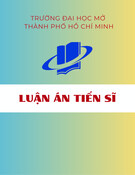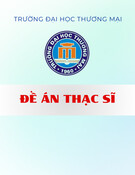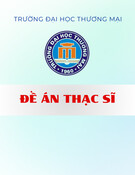
THE MINISTRY OF EDUCATION AND TRAINING
UNIVERSITY OF ECONOMIC HOCHIMINH CITY
----------------------------
THE STUDY OF RELATIONSHIP BETWEEN THE
QUALITY OF ACCOUNTING SOFTWARE AND
ACCOUNTING, ORGANIZATIONAL AGILITY,
ENTERPRISE PERFORMANCE IN VIETNAM
Major: Accountancy
Code: 9.34.03.01
DOCTORAL THESIS - SUMMARY
HOCHIMINH CITY – 2019

The thesis was complete at:
University of Economics Ho Chi Minh City
Supervisor:
Assoc. Prof. Dr. Vo Van Nhi
Reviewer 1:
Reviewer 2:
Reviewer 3:
The thesis will be presented to the University Dissertation
Board at:
At …. …. day ... month .... year ….
The thesis can be found at the library:

1
INTRODUCTION
1. Statement of Problems
Most Vietnamese enterprises, including large-scale enterprises, use accounting software, only a
few enterprises use Enterprise Resource Planning (ERP). This can be seen, accounting software
plays an important role in management and administration of Vietnamese enterprises. Therefore,
it is necessary to study on the role of accounting software application for business activities,
starting from the characteristics of software application of Vietnamese enterprises.
Studies of the effect of information technology (IT) application in general and management
software in particular for accounting activities and accounting systems have already implemented
in many countries around the world. However, most of these studies considered application of
ERP or integrated software in developed countries such as the US, Europe, Taiwan, South Korea
... or some developing countries such as China. On the other hand, when studying the relationship
between software applications, these studies only mentioned the process of software application
and system. There is no research directly mentioning the relationship between the quality of
deployed software and the benefit of accounting in general as well as management accounting
activity brought by software application.
The relationship between IT application or management software, ERP software with
organizational agility and operational effectiveness of enterprises has been verified through many
studies. However, most of the studies conducted in the ERP application environment or integrated
software, not merely accounting software and there is no research investigating the direct
relationship between software quality and organizational agility and firm performance.
In Vietnam, there is a few research on information technology application in accounting. Most of
them focus on organizing information systems in general. There are several researches on the
ERP application for specific industries. There is no research investigating the impact of quality of
accounting software on the accounting system in general and management accounting activity in
particular. There is also no research investigating the impact of qualified software on
organizational agility and the performance of enterprises. Therefore, the thesis with the topic
“The study of relationship between the quality of accounting software and accounting,
organizational agility, enterprise performance in Vietnam” is chosen to study.
2. Thesis Objectives and Questions
The overall objective of this thesis was to investigate the relationship between quality of
accounting software and accounting benefit provided by software application, management
accounting activity, organizational agility and enterprise performance.
Starting from the objective, the thesis would find the answers for the following questions:
(1) Which benefits could the quality of accounting software bring to accounting?
(2) How did the quality of accounting software impact on enterprises’ management
accounting activity?
(3) How did the qualified accounting software have benefits on increasing organizational

2
agility?
(4) Did the use of qualified accounting software have a positive effect on operational
effectiveness of enterprises?
(5) Did the accounting benefit provided by software application promote management
accounting activity?
(6) Did an increase in organizational agility promote enterprise performance?
3. Subject and Scope
The subject of the study: the relationship between the quality of accounting software with the
benefit of accounting provided by software application, management accounting activity,
organizational agility and enterprise performance.
The subject of the survey and the scope of the study: Enterprises using accounting software,
having management accounting activities and published financial report in 2017.
4. Research Method
The thesis used mixed research methods including qualitative and quantitative research.
5. Thesis Contribution
- In terms of theory: the study explored concepts of quality of accounting software, accounting
benefit provided by software application, management accounting activity, organizational agility
and enterprise performance as well as theories which had not been studied and tested on using
accounting software in Vietnamese enterprises such as relationship between the quality of
accounting software and the accounting benefit provided by software application, management
accounting activity, organizational agility and performance of Vietnamese enterprises. These
contributed to related theories in this field research.
- In terms of practice: the research model explored and tested would give many important
implications in the process of applying accounting software, organizing accounting activities to
meet changing conditions of business environment and to bring efficiency to enterprises.
CHAPTER 1: LITERATURE REVIEW
1.1 An Overview of Studies Abroad
1.1.1 Effect of IT on Accounting Activity
The application of information technology systems, representing by ERP in enterprises, had
shown impact on accounting activity (Booth et al., 2000; Spathis and Constantinides, 2004;
Kanellou and Spathis, 2013; Attayah and Sweiti, 2014). Spathis (2006), Abbasi et al. (2014),
Goumas et al. (2018) provided benefits gained by ERP application. Other studies showed that
using ERP had an impact on management accounting activity (Granlund and Malmi, 2002;
Spathis and Ananiadis, 2005; Rom and Rohde, 2006; Scapens and Jazayeri, 2010; Ponorica et al.,
2015). Other studies focused on the impact of ERP on enterprises’ operational effectiveness
(Etemadi and Kazeminia, 2014). Most recent research about the impact of IT on accounting was
related to ERP.

3
1.1.2 Effect of IT on Organizational Agility.
According to Coronado and Colin (2002), Van Oosterhout & ctg (2006), Raschke (2010), Chen et
al. (2014), IT facilitated enterprises' agility. These studies affirmed the positive impacts of IT on
enterprises' agility, but only mentioned IT or ERP applications.
1.1.3 Effect of IT on Enterprise Performance
Poston and Grabski (2001), Spathis and Constantinides (2003), Raschke (2010), Chen et al
(2014), Etemadi and Kazeminia (2014) had done research on relationship between IT (especially
effects of ERP) on enterprises’ operational effectiveness.
1.1.4 Effect of Accounting Activities on Agiability
Järvenpää (2007) studied the impact of management accounting on culture and business
orientation of enterprises. Foster and Young (1997), Adler et al. (2000) analyzed the impact of
management accounting on activities of management, motivation and organization. Shields
(1997) analyzed the impact of management accounting on the organizational agility.
1.1.5 Effect of organizational agility on Enterprise performance
Some studies found relationship between organizational agility and operational effectiveness.
According to Haeckel (1999), Ganguly and Farr (2009), enterprises that were able to react
quickly to the environment will develop successfully. Sánchez and Pérez (2005), Glenn (2009),
Ganguly and Farr (2009), Mccann et al. (2009), Yang and Liu (2012) found a positive
relationship between business agility and operational effectiveness. Some studies considered the
impact of the environment on this relationship (Chen et al., 2014).
1.2 An Overview of Related Studies in Vietnam
The current study had synthesized doctoral dissertations in the National Library, articles in
scientific journals on management and economic management in Vietnam such as the Journal of
Economic Development, the Journal of Economics and Development, and the Journal of
Accounting and Auditing from 2000 to present with keywords such as "accounting information
system", "machine accounting", "accounting software", "accounting informatics", "ERP". The
combined results of the studies were classified into groups: (1) Research on accounting
information systems in general; (2) Research on ERP application in accounting and (3) research
on accounting software application.
1.3. Conclusion and Research Gap
1.3.1 Conclusion
There had been many studies conducted on the role of IT for accounting and management
accounting in general as well as their impact on operational effectiveness or benefits of
enterprises. However, there had not been research on application of accounting software, impact
of the quality of accounting software on business activities. There had not been research on
benefits of accounting software and impact of management accounting on organizational agility.
There was a research gap between management accounting and organizational agility.
Studies of information technology application in Vietnam were classified into groups: (1)


























